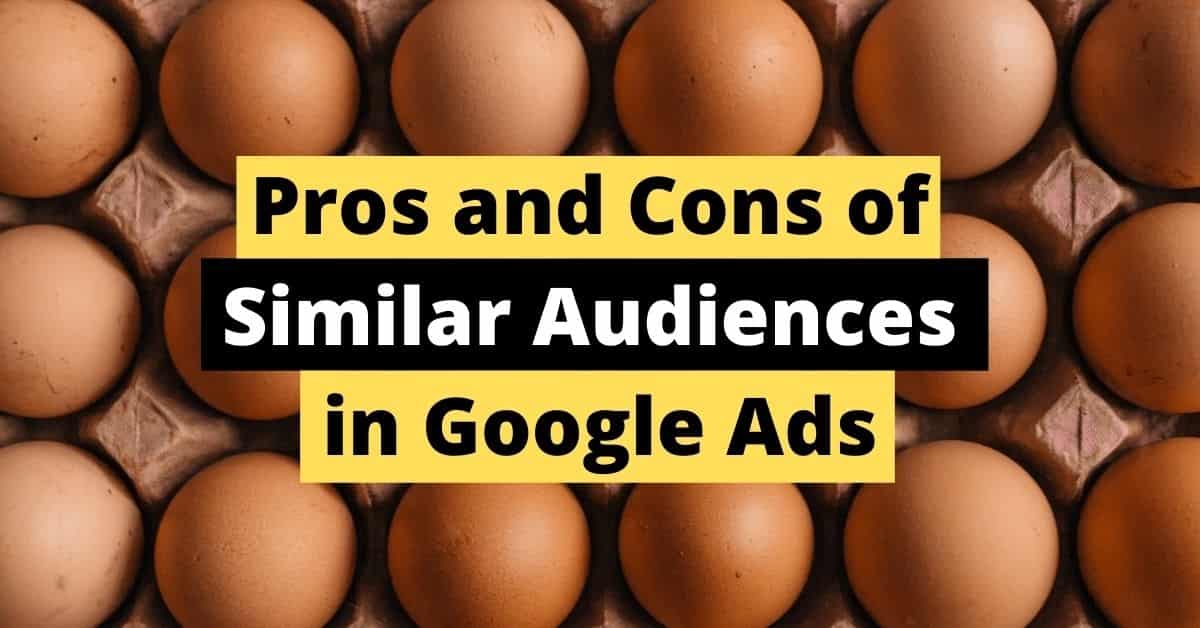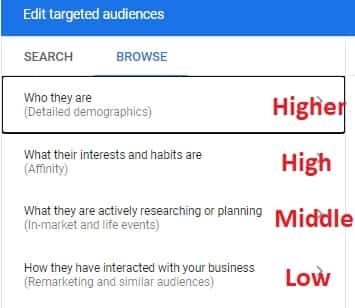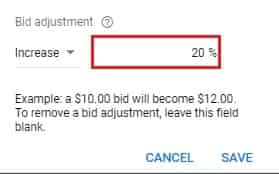13 Pros and Cons of Similar Audiences in Google Ads

Have you ever thought of bringing new but at the same time high-quality leads to your business?
Or maybe you complain about how small is the size of your remarketing list.
Well, here is the solution you might want to consider.
In this article, we are going to list all the pros and cons of similar audiences in Google ads and things to keep in mind when using them in your campaigns.
Briefly about similar audiences
Similar audiences are a group of people who have similar interests and behaviors to people in your remarketing list or customer match list.
It works basically the same as Facebook lookalike audiences but named with another terminology.
Google ads creates similar audiences automatically if your remarketing list meets certain criteria.
The difference of this approach from other Google audience targeting methods is that you won’t target general-interest categories like Education, Travel to Europe, etc., which are in the Affinity and In-market audiences. But, each targeting methods are unique for different types of websites and different types of remarketing lists on the same website depending on the customer behavior.
This targeting method is a low of the funnel targeting method in Google ads.

Because the ads are more relevant and their reach is narrower compared to other targeting methods.
Pros of Similar audiences in Google ads
1. No time spent on audience creation
To create similar audiences, you don’t have to spend time to make research and segment your target audiences.
If you have a remarketing tag added to your website, it is generated automatically by Google ads from your remarketing lists without you doing anything manually.
However, your remarketing list should meet certain requirements to generate similar audiences. (We’ll discuss it later in the article)
2. Updating changes in real-time
Once a similar audience is created, the changes that happen in the remarketing list also reflect upon the similar audience list immediately.
For example, the site visitors who came to your website by using the phrase “SEO guide” in the past, may use the “SEO cheat sheet” phrase now. And that signals the change in the behavior of people in the remarketing list and as a result, similar audience list is also updated.
So you don’t have to create a new similar audience, because Google ads updates it in real-time.
3. Acquiring new users or acquiring more users than remarketing
Similar audiences allow you to acquire new users that behave similarly to the existing ones.
According to Google, it can generate up to 5 times more visitors to your website than remarketing does.
According to Wordstream, similar audiences for search on average target 7 times larger audiences than simple RLSA campaigns.
4. Uses machine learning
When creating similar audiences, Google ads uses machine learning technology, by analyzing millions of factors and metrics to find similarities of it with remarketing audiences.
To create a similar group of people, Google analyzes the activities in Google networks and Google partner sites for the last 30 days. Then, it finds the shared interests and characteristics of visitors with remarketing lists.
5. More conversions
According to Google internal data, when users use similar audiences with remarketing campaigns they usually see around 41% more conversions.
Another case study of higher conversions can be seen when Fiat Chrysler Automobiles used similar audiences and saw 22% more conversions and reduced their CPA by 14%.
TIP: In order to achieve the highest conversion as possible with similar audiences, pick the lowest part of the sales funnel, such as Purchase, Form submission, etc. And use the similar audiences of those interactions.

In this way, you can take your highest chance with your similar audience targeting.
6. Excludes existing visitors automatically
When targeting similar people to your remarketing list, the list doesn’t include the users of the remarketing list.
It just automatically excludes the users found in the remarketing list even if they meet the criteria of similarity.
For example, User A may have all the qualities to be similar to the people in the remarketing list, but if that person is also included in the remarketing list, he will be automatically removed from the similar audience list.
7. You can use broad match keywords
As used with remarketing campaigns, you can also use broad match keywords with similar audiences depending on your industry.
Because the visitors are already pre-qualified by Google ads on other websites or platforms, there is a higher chance that your ads can be shown to people who are more interested in your products or services.
So, in some categories, if you have a fewer number of people in a similar audience list, you can expand its size by targeting broader keywords.
8. Increasing bids for higher probability similar audiences
As there can be several similar audiences by different categories in one account, one can be more important than the other.
For the higher probability ones, you can bid higher by adjusting the bids. For less targeted ones you can keep the bids unchanged or decrease them.

Let’s see an example.
To be as efficient as possible in your targeting:
- You can increase the bids by 20% for the users similar to converters
- Leave the bids unchanged for the users similar to cart abandoners
- Decrease the bids by 20% for the users similar to visitors who browse the website without any important interactions
Cons of Similar audiences in Google ads
1. Not available for shopping campaigns
Similar audiences are available for Display network, Search network, YouTube, Gmail, and apps.
They are not available for Shopping campaigns.
2. Audience size requirements
Depending on the campaign type you are using, your remarketing list must meet different audience size requirements. Then, similar audiences can be created according to that.
- Google Display Network must have a minimum of 100 active visitors within the last 30 days.
- Google Search Network, YouTube, Gmail must have a minimum of 1,000 active visitors within the last 30 days.
3. May not find similarity with remarketing lists
Even if you have enough users in your remarketing list, Google ads may not be able to generate similar audiences from it and the list may appear as unavailable in the Audience Manager section.
Because the number of people in the list still may not be statistically significant. So, the data of the existing visitors of your website may not be big enough to make accurate decisions.
That means, the smaller the remarketing list, the less likely it is to find similarities between remarketing and similar audiences.
So, you have to wait until your remarketing list gets bigger or the machine learning finds some similarities over time.
4. Similar Audience size might be too small
After Google ads finds some similarities, for some reason similar audience sizes might be small.
Possible reasons might be:
- It is generated from a remarketing list that is too narrow. Try expanding it by choosing a bigger audience
- The campaign might be too targeted by demographics or you are bidding too low for the campaign. Try expanding your reach by targeting broadly or increasing bids
5. Other Cons
Targeting other than your business location
If you run similar audiences for your campaigns, it targets a similar group of people without any restrictions on locations.
For example, if you run your ads in English, your ads might be shown to all English-speaking countries.
To narrow down the reach of your ads you need to set location targeting when creating a new campaign.
Doesn’t support sensitive categories
Like many other audience-targeting methods, you cannot run ads for sensitive categories like Health, Relationships, Political affiliation, etc. Therefore, you should follow the guidelines of personalized advertising.
It takes some time to generate a new list
Once you create a new remarketing list, it takes about 48 to 72 hours to generate a similar audience list.
So, you have to wait until machine learning finds shared similarities and characteristics between the people in your remarketing list and people from other websites.
Conclusion
That is all you need to know about the pros and cons of similar audiences.
This targeting method is a low of the funnel targeting method.
So, if you implement similar audiences whenever you are using Google ads, you can increase the efficiency, relevancy, and conversion rate of your ads.
What other features do you know about similar audiences?
Let me know in the comments section below…
For any help with your Google ads management, contact me through the Contact page.

